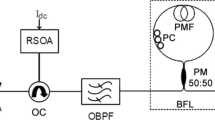Abstract
It is important to consider optical reflectionconditions when designing fiber-oriented wirelessaccess systems around subcarrier optical transmissionsince the noise characteristic can be significantlydegraded by optical reflection, especially if narrowspectral width devices are used. The superluminescentdiode (SLD) offers stable noise and 3rd-orderintermodulation distortion (IM3) characteristics thatfollow the ideal cubic law, even under multipleoptical reflection. The SLD-predistorter combinationis proposed as a way to overcome the SLD's narrowdynamic range. It is experimentally found that thepredistorter reduces IM3 by 8 dB. The receiversensitivity of a practical system that uses theSLD-predistorter combination is discussed from theviewpoint of overall design. A superimposedsubcarrier modulation (SSM) technique is also proposedin order to reduce the reflection noise. Weexperimentally confirm that the SSM technique reducesthe noise degradation and provides stable opticaltransmission. An SSM design methodology is presentedthat takes both noise and linearity into account. TheSLD-predistorter and the SSM scheme make it possibleto realize stable transmission performance and widerdynamic range in the presence of optical reflection.
Similar content being viewed by others
References
R. Olshansky et al., “Subcarrier Multiplexed Lightwave Systems for Broadband Distribution”, IEEE J. Lightwave Technol., Vol. 7, No.9, pp. 1328–1340, 1989.
W.I. Way, “Subcarrier Multiplexed Lightwave System Design Consideration for Subscriber Loop Application”, IEEE J. Lightwave Technol., Vol. 7, pp. 1806–1808, 1989.
D.C. Cox, “Portable Digital Radio Communications – an Approach to Tetherless Access”, IEEE Commun. Mag., Vol. 27, No.7, pp. 30–40, 1989.
J.A. Chiddix, “AM Video on Fiber in CATV Systems: Need and Implementation”, IEEE J. Select. Areas Commun., Vol. 8, No.7, pp. 1229–1239, 1990.
M. Maeda et al., “FM-FDMOptical CATV Transmission Experiment and System Design for MUSE HDTV Signals”, IEEE J. Select. Areas Commun., Vol. 8, No.7, pp. 1257–1267, 1990.
T.E. Darcie, “Subcarrier Multiplexing for Lightwave Networks and Video Distribution Systems”, IEEE J. Select. Areas Commun., Vol. 8, No.7, 1240–1248, 1990.
A.J. Cooper, “Fiber-Radio: A New Technique for Delivering Cordless Access Services”, in Proc. ICC'90, June 1991, pp. 999–1005.
T. Murase et al., “The Latest Transmission Techniques and Future Outlook on Radio Systems”, in Canadian Conf., Sept. 1991.
H. Ohtsuka et al., “A Subcarrier Transmission Approach to Microcellular Systems”, in Proc. ICC'92, Sep. 1992, pp. 33.03.1–33.03.4.
H. Ogawa et al., “Fiber Optic Millimeterwave Link for Personal Mobile Radio System”, IEEE Trans. Microwave Theory and Tech., Vol. MTT-40, No.12, pp. 2285–2293, 1992.
M. Shibutani et al., “Optical Fiber Feeder for Microcellular Mobile Communication Systems”, IEEE J. Select. Areas Commun., Vol. 11, No.7, pp. 1118–1126, 1993.
K. Morita et al., “The New Generation of Wireless Communications Based on Fiber-Radio Technologies”, IEICE Trans. Commun., Vol. E76-B, No.9, pp. 1061–1068, 1993.
D.M. Cutrer et al., “Dynamic Range Requirements for Optical Transmitters in Fiber-Fed Microcellular Networks”, IEEE Photonics Technology Letters, Vol. 7, No.5, pp. 564–566, 1995.
S. Komaki et al., “Requirements for Radio-Wave Photonic Devices from the Viewpoint of Future Mobile Radio Systems”, IEEE Trans. Microwave Theory and Tech., Vol. MTT-43, No.9, pp. 2222–2228, 1995.
S. Ryu et al., “Measurement of Direct Frequency Modulation Characteristics of DFB-LD by Delayed Self-Homodyne Technique”, Electron. Lett., Vol. 22, No.20, pp. 1052–1054, 1986.
M.M. Choy et al., “Interferometric Conversion of Laser Phase Noise to Intensity Noise by Single-Mode Fiber-Optic Components”, Electron. Lett., Vol. 23, No.21, 1987.
H. Yoshinaga et al., “Influence of Reflected Light on Erbium-Doped Fiber Amplifiers for Optical AM Video Signal Transmission Systems”, J. Lightwave Technol., Vol. 10, No.8, 1992.
M. Yamada et al., “Analysis of Excess Noise Induced by Optical Feedback in Semiconductor Lasers Based on Mode Competition Theory”, The Transaction of IEICE, Vol. E73, No.1, 1990.
O. Mikami et al., “Emission Spectral Width Broadening for InGaAsP/InP Superluminescent Diodes”, IEE Proceedings-J, Vol. 138, No.2, pp. 133–137, 1991.
Y. Noguchi et al., “Tandem Active Layer Superluminescent Diode with a Very Wide Spectrum”, Appl. Phys. Lett., Vol. 58, No.18, pp. 1976–1978, 1991.
T. Shiozawa, M. Shibutani and J. Namiki, “Upstream-FDMA/Downstream-TDMA Optical Fiber Multiaccess Network”, in Proc. ICC'92, pp. 304.7.1–304.7.5, 1992.
K. Asatani and T. Kimura, “Linearization of LED Nonlinearity by Predistortions”, IEEE Trans. ED, Vol. ED-25, No.2, 1978.
J. Namiki, “An Automatically Controlled Predistorter for Multilevel Quadrature Amplitude Modulation”, IEEE Trans. Com., Vol. COM-31, No.5, 1983.
K. Sato et al., “Speckle Noise Reduction in Fiber-Optic Analog Video Transmission Using Semiconductor Laser Diode”, IEEE Trans. Communications, Vol. COM-29, No.7, 1981.
Y. Aburakawa et al., “Predistorter Implementation to SLD in Fiber Optic Wireless Systems”, IEICE Trans. Electron., Vol. E79-C, No.1, pp. 52–59, 1996.
Y. Aburakawa et al., “Signal and Extraction with Frequency Arrangement and Superimposed Subcarrier Modulation Schemes in Fiber-Oriented Wireless Access Systems”, IEEE J. Lightwave Technol., Vol. 15, No.12, pp. 2223-2231, 1997.
Author information
Authors and Affiliations
Rights and permissions
About this article
Cite this article
Aburakawa, Y., Ohtsuka, H. Linearity and CNR Improvement Technologies against Optical Reflection in Fiber-Oriented Wireless Access Systems. Wireless Personal Communications 15, 145–160 (2000). https://doi.org/10.1023/A:1008976107635
Issue Date:
DOI: https://doi.org/10.1023/A:1008976107635




